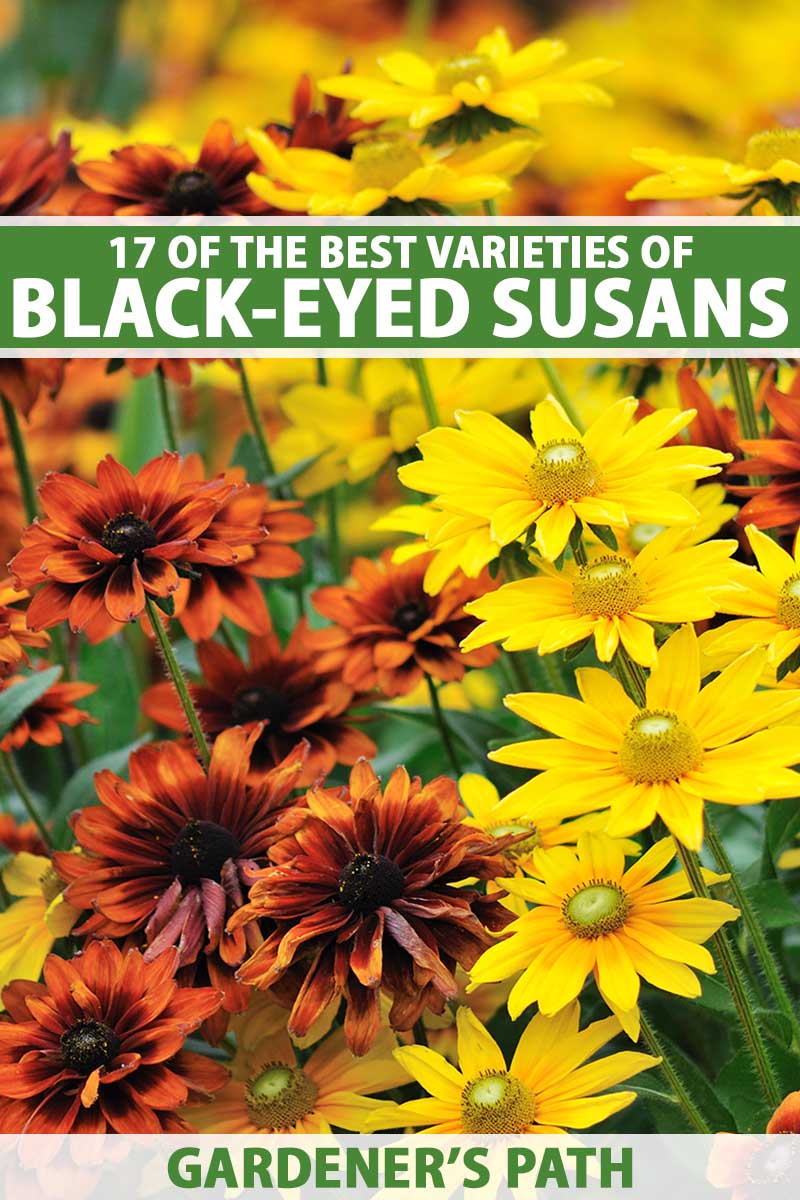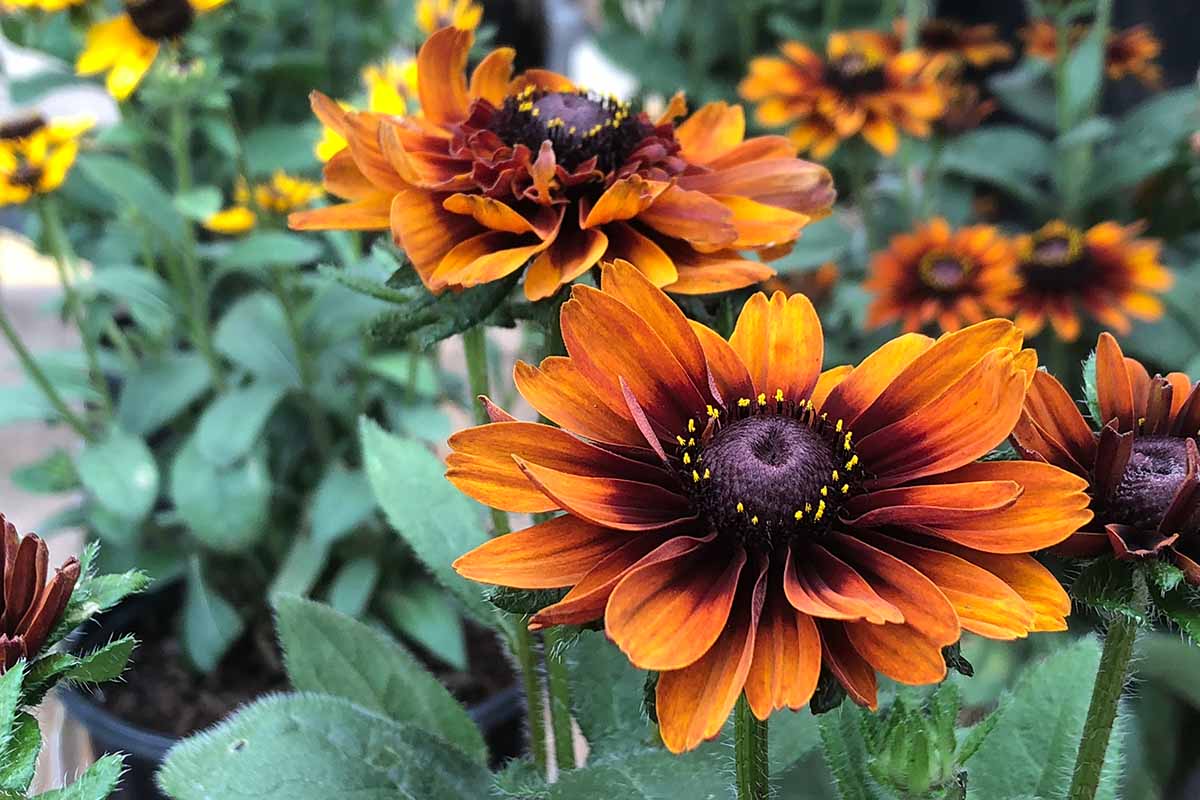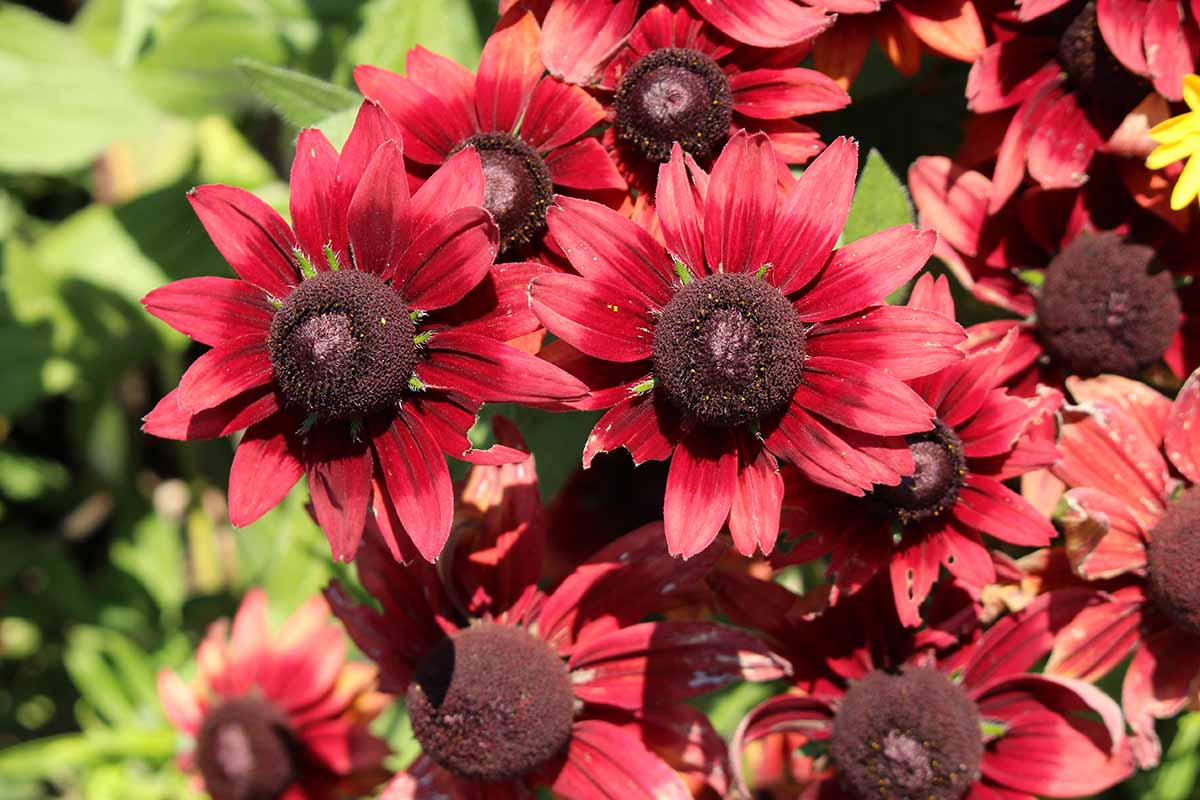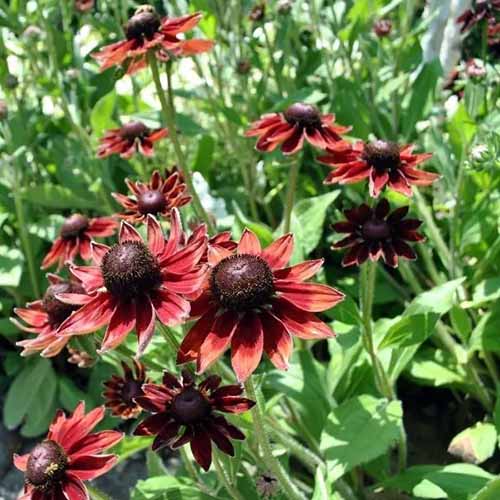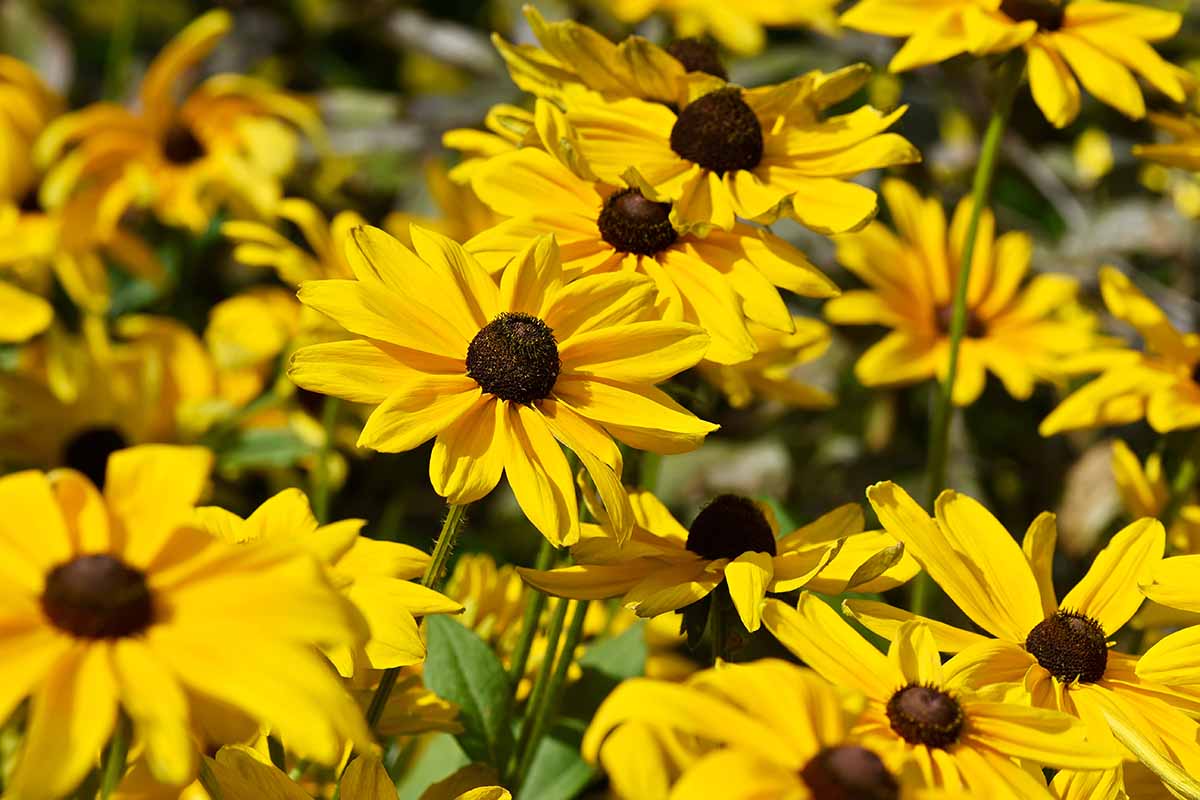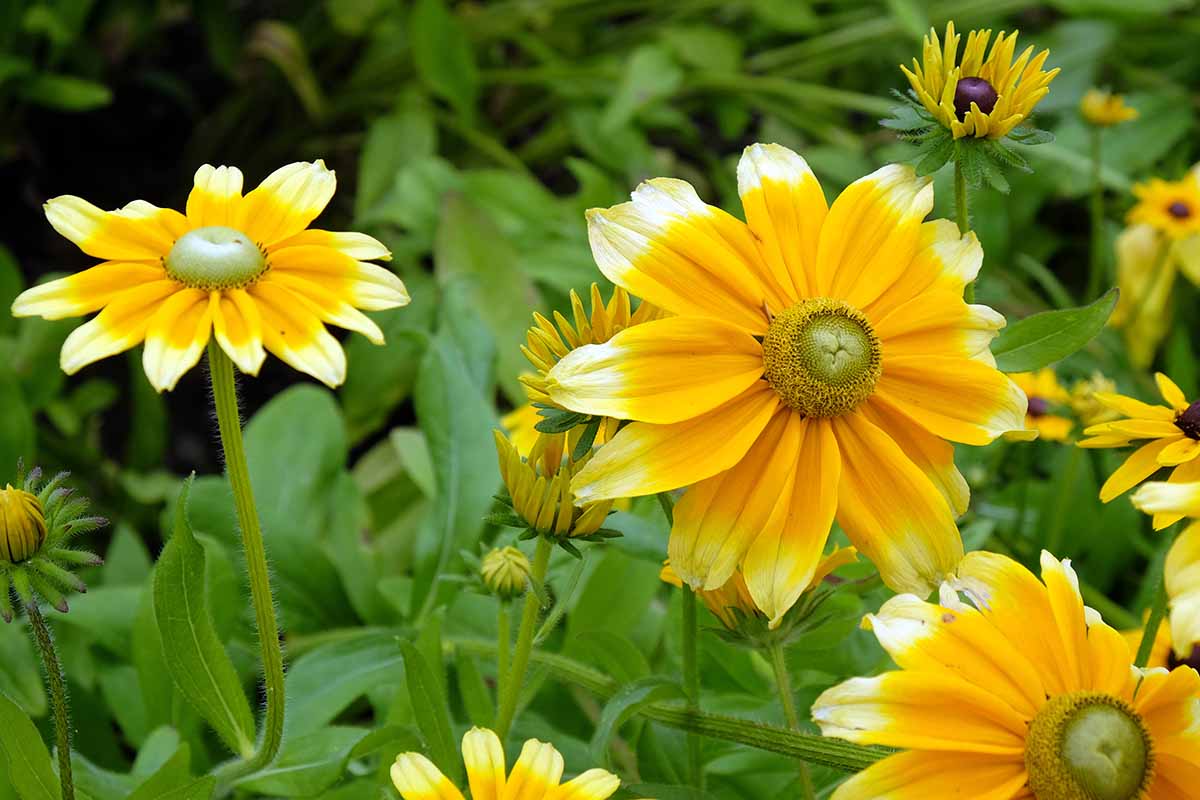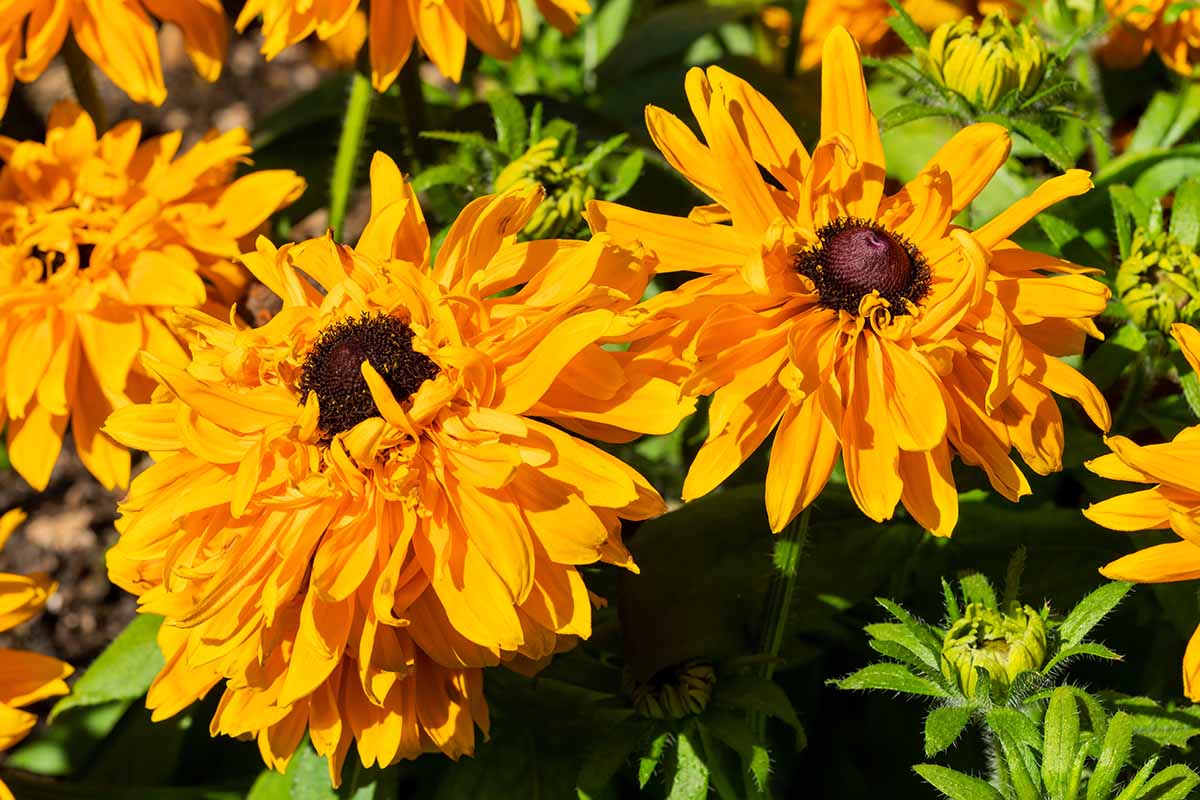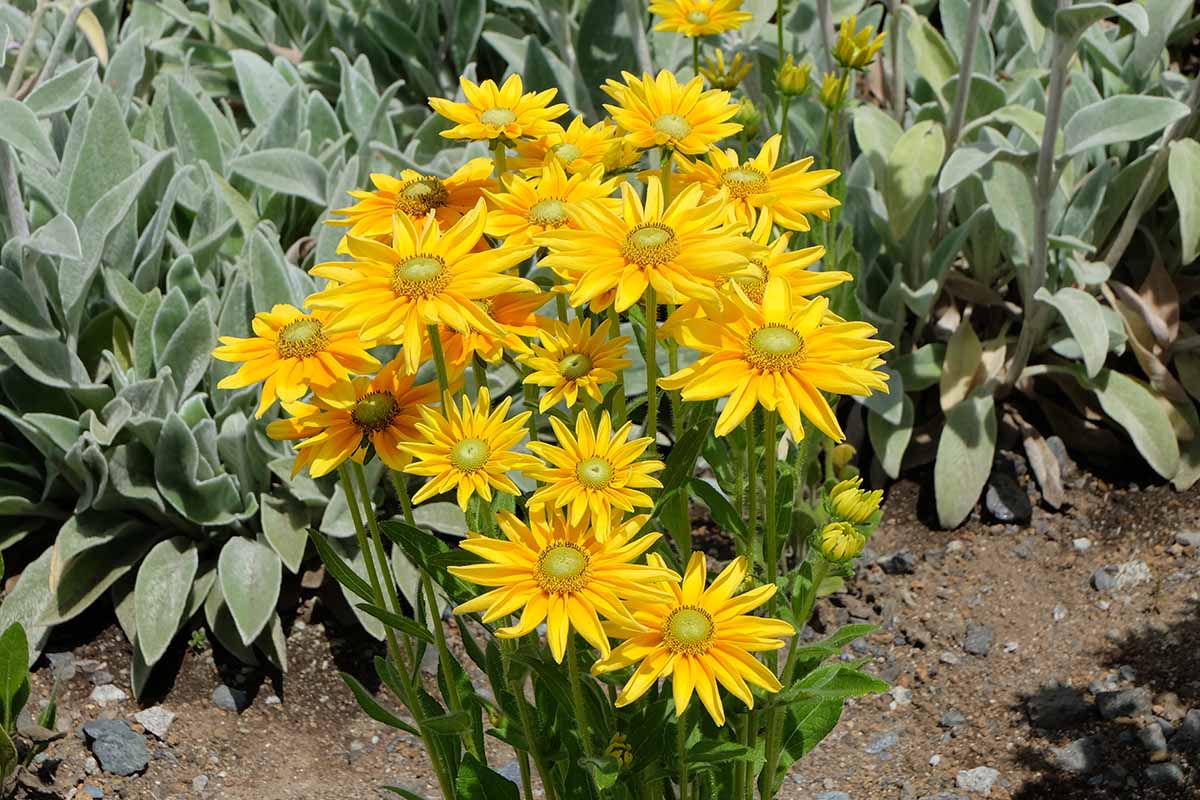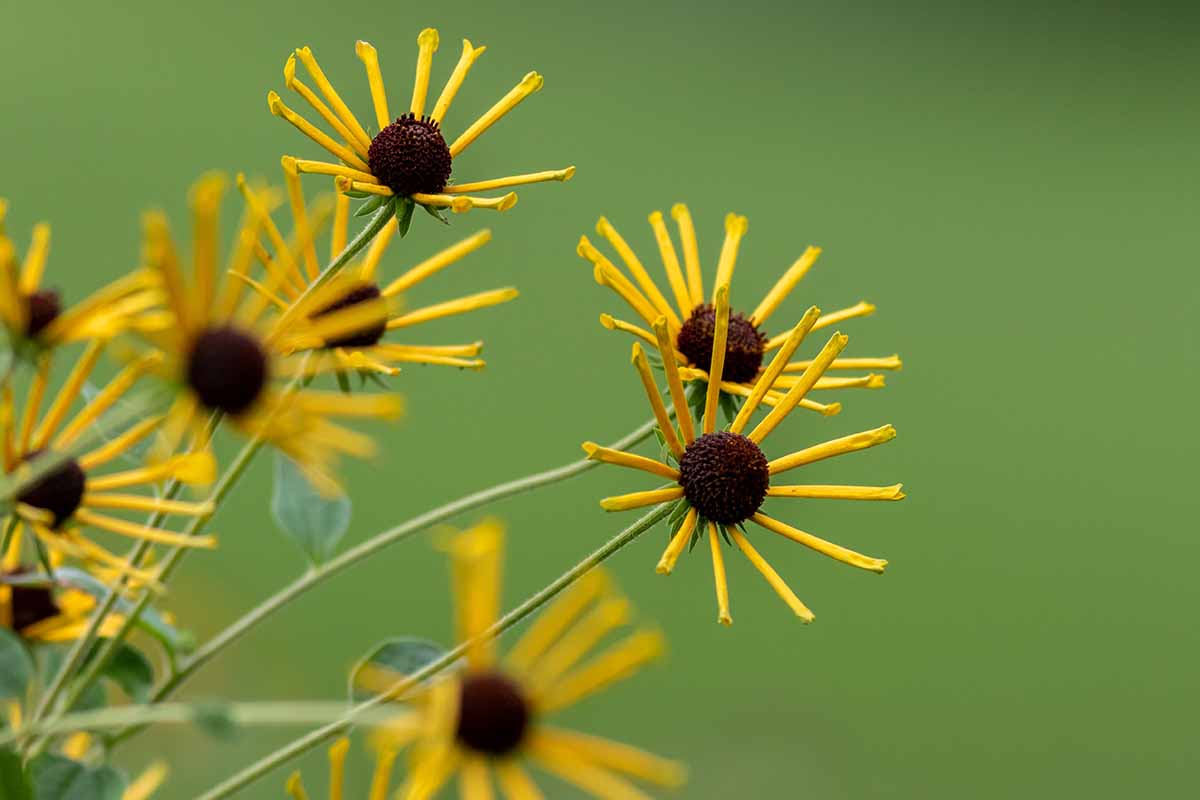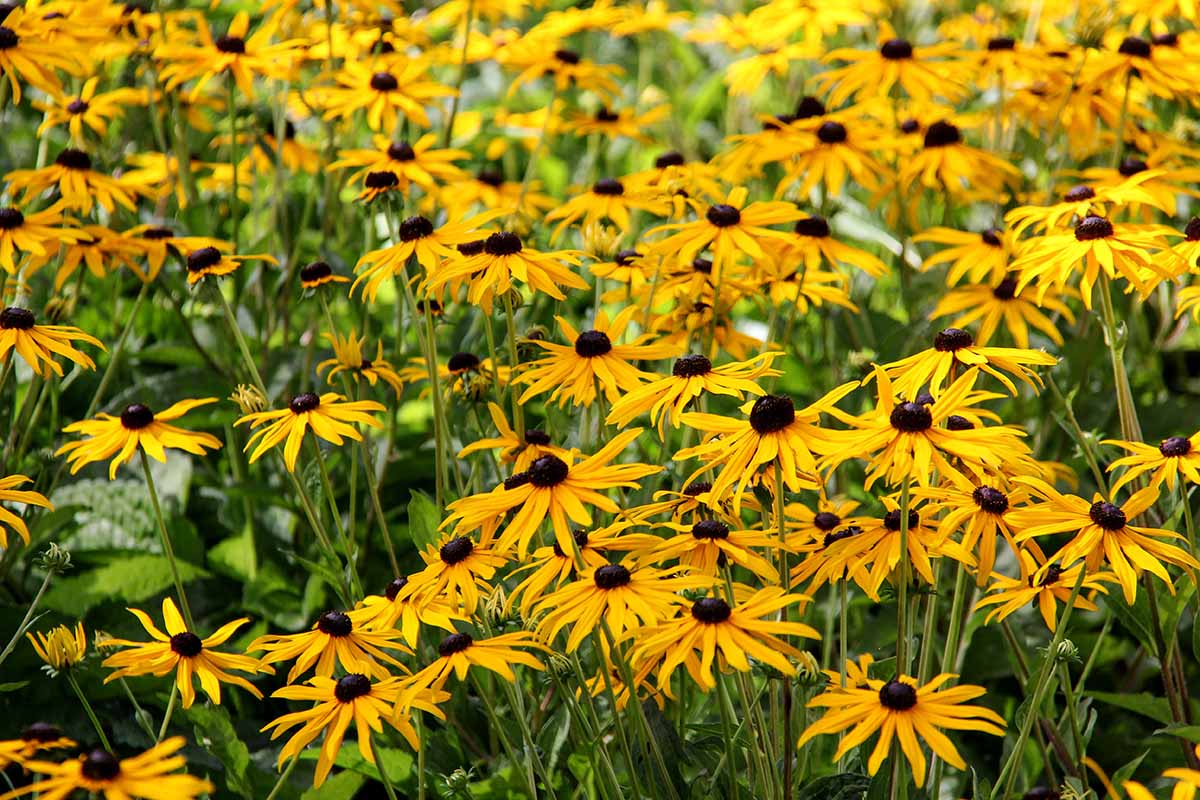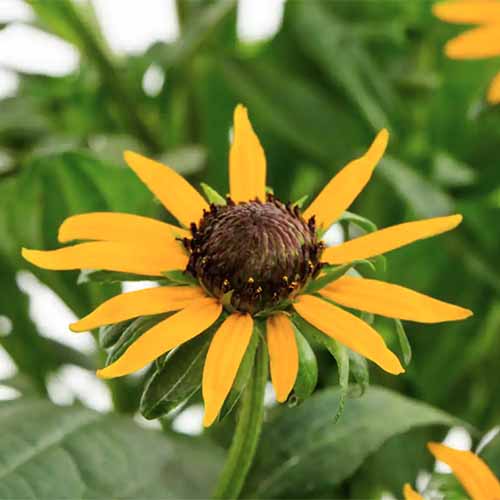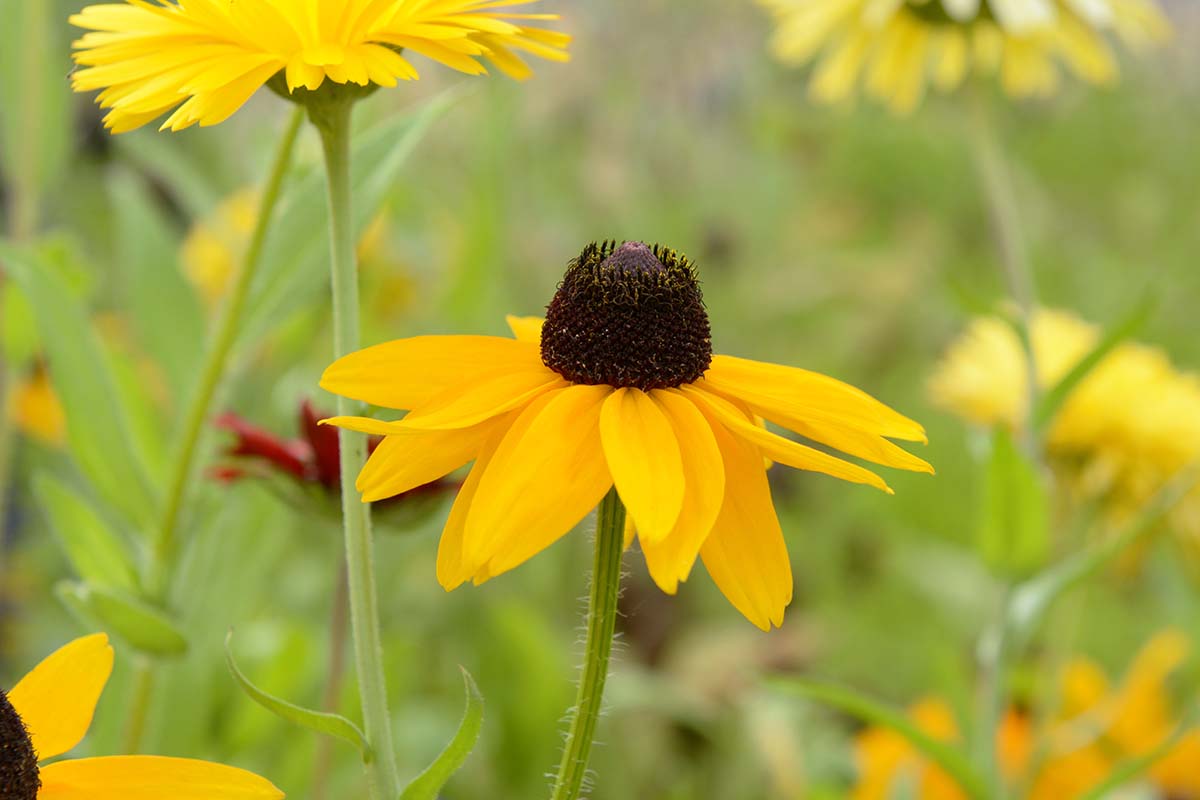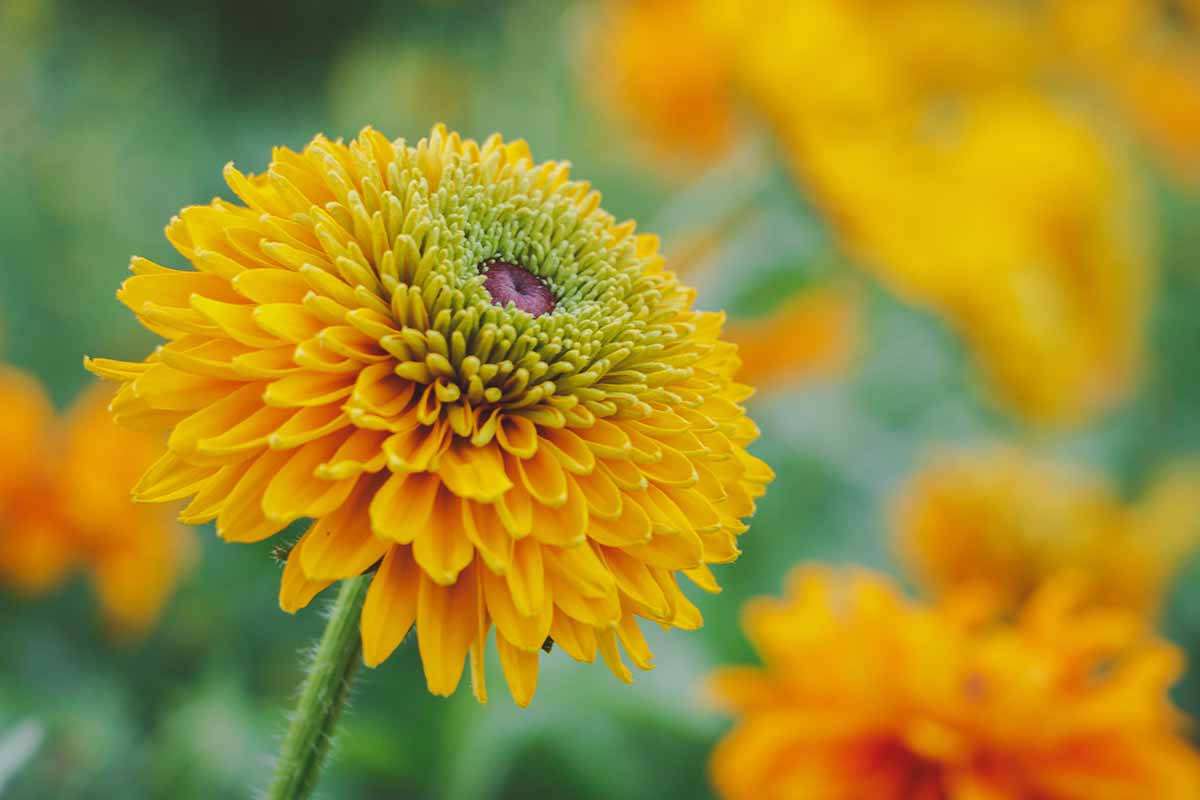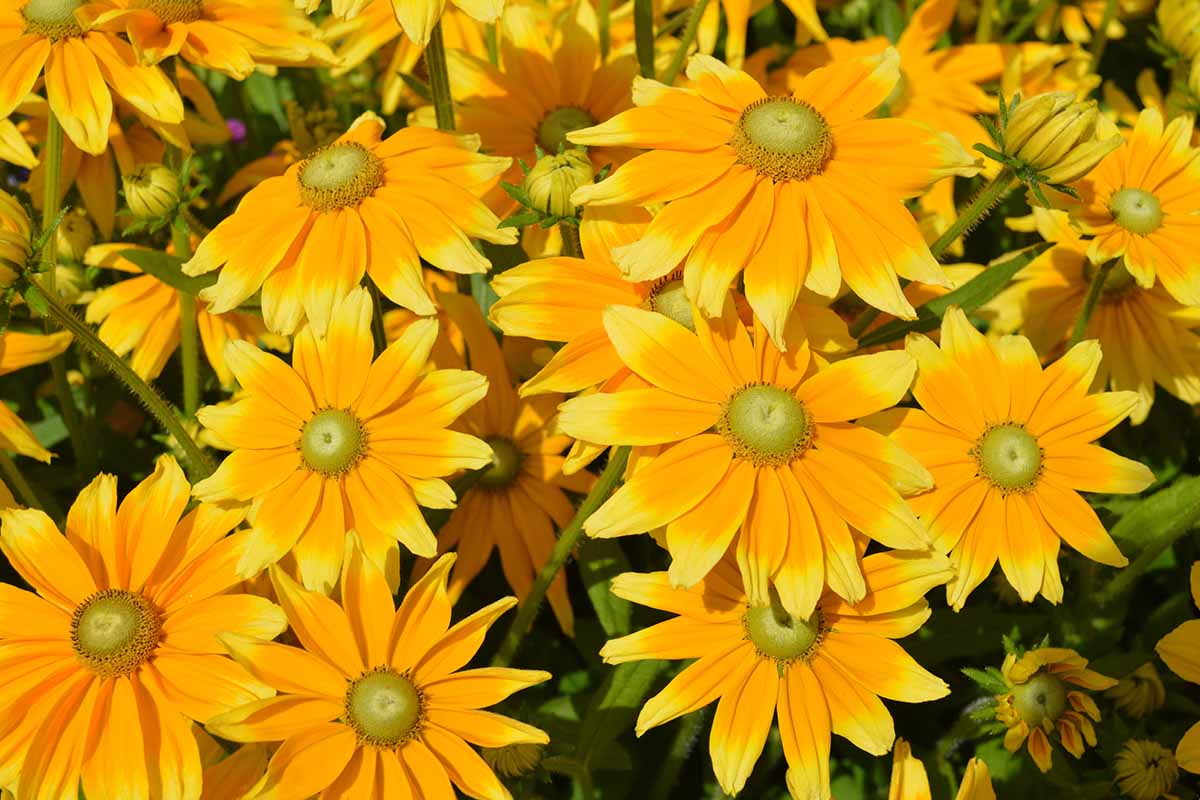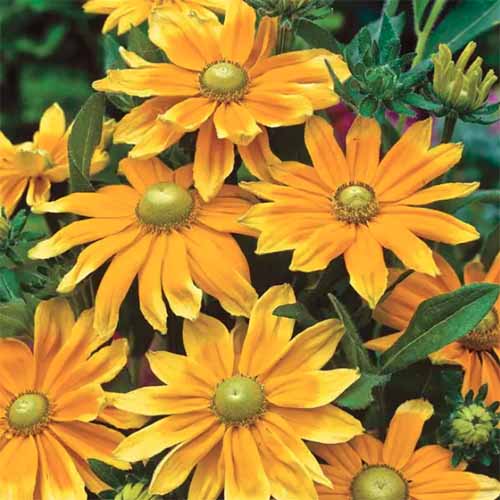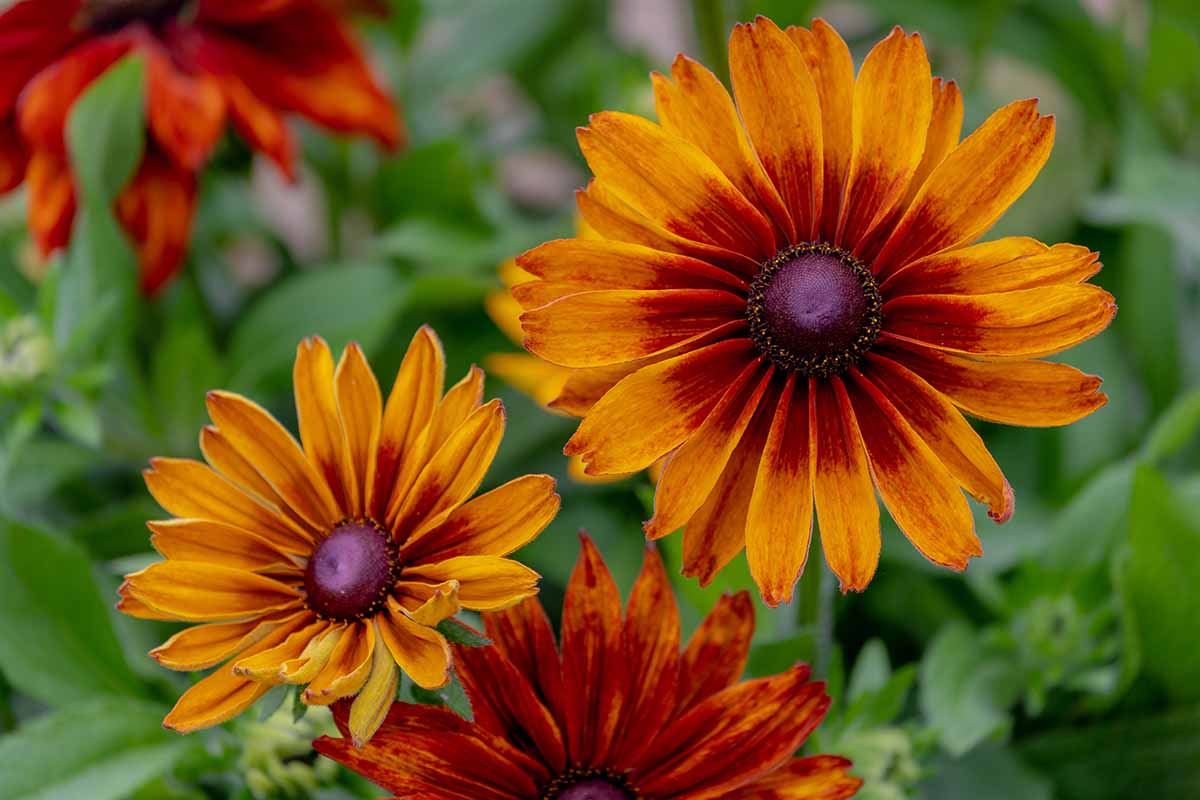It’s true, black-eyed Susans don’t have the variability that something like roses or poppies do. People might assume the blooms generally have the same appearance and a similar color. But there’s actually quite a bit of variety available. We link to vendors to help you find relevant products. If you buy from one of our links, we may earn a commission. In other words, you don’t have to assume that you’ll only be able to find one general appearance if you’re hoping to add this hardy North American native to your garden. You’ve got options! If you need a refresher on how to grow black-eyed Susans, check out our guide. In this guide, we’re going to go over some of what we think are the best varieties. Here’s a preview of our list: A quick primer on black-eyed Susan anatomy before we get into the roundup, so we’re all on the same page when we talk about the different parts of the flower. Each flower head has ray florets (the colorful “petals”) surrounding petal-like disk florets at the center. It’s those disk florets that we call the eye. Like what you’ll see in their cousins, purple coneflowers, these disk florets have a sort of cone shape, though it can range from something that protrudes quite a bit to just a small mound.
1. Autumn Forest
A Rudbeckia hirta cultivar, ‘Autumn Forest’ has massive yellow, red, and mahogany flowers that can reach five inches across. This compact R. hirta plant only grows to about 18 inches tall, but that doesn’t mean it can’t make an oversized impact. The bright blooms smother the bushy foliage from early summer until winter is just around the corner. ‘Autumn Forest’ Create your own autumn forest by grabbing a small pack or an ounce of seeds at Eden Brothers.
2. Cappuccino
Relax and sit back with a nice tall iced coffee (iced tea would also work) and enjoy your garden as the yellow, gold, orange, and mahogany flowers of ‘Cappuccino’ sway in the breeze. Winner of the Award of Garden Merit from the Royal Horticultural Society, it’s extra drought-tolerant and makes a good cut flower option.
3. Cherokee Sunset
R. hirta ‘Cherokee Sunset’ isn’t like other black-eyed Susans. It captures the spirit of the mahogany, red, orange, and yellow of a summer sunset as the sun drops below the horizon. Each petal starts at the base with a deep mahogany that gradually transitions to red, orange, and finally, it’s tinged at the tip in yellow. The eye at the center is dark mahogany brown, all set against dark blue-green foliage. Reaching two feet tall, this plant blooms profusely from midsummer through the fall. All this combined nabbed ‘Cherokee Sunset’ the All-America Selections award in 2002.
4. Cherry Brandy
Not a huge fan of yellow flowers? Or just looking for something different? R. hirta ‘Cherry Brandy’ has red rays that start crimson at the center and fade to cherry red at the tips. The floret at the center is rounded and protruding, in a deep maroon-brown color. Each plant can reach up to four feet tall and is covered from head to toe in blossoms. ‘Cherry Brandy’ Head to Nature Hills Nursery to sweeten up your garden with this petite stunner.
5. Double Golden Gloriosa
This standout has four-inch-wide, bright yellow, double blossoms and a small black eye at the center on top of three-foot-tall stems, making for a glorious display from May through October. When you cut a stem for a cut flower display, the blossoms tend to stay fresh and new-looking much longer than some others. ‘Double Golden Gloriosa’ Pick up a small packet or an ounce of seeds at Eden Brothers if you want to make this one part of your summer garden.
6. Indian Summer
For a classic R. hirta cultivar, you can’t go wrong with ‘Indian Summer.’ The oversized, semi-double blooms feature golden petals surrounding a black center. It’s such a heavy bloomer that you might not even be able to see the foliage for the profusion of blossoms, providing you with a long-lasting display that will stay true through even the hottest dog days of summer. This one is such a standout that it nabbed the All-America Selections award in 1995 and the Royal Horticultural Society Award of Garden Merit in 2000.
7. Irish Eyes
It’s impossible not to smile when you see this R. hirta cultivar nodding in the breeze. A bright green central disk is surrounded by orange and lemon-yellow petals that are particularly long and wide. The 30-inch tall stems are long and straight, perfect for cuttings. Plus, this plant blooms even more profusely if you regularly cut it back, so it’s a win-win, since you’ll see more flowers outside while you also have more for your vases inside. The plant itself is tall, up to four feet, and one of the most reliable, long-blooming cultivars. ‘Glitters Like Gold’ captures that spirit with its elegant, extremely long golden petals around a petite black eye. The plant is a prolific bloomer but stays relatively petite at 18 inches tall. ‘Glitters Like Gold’ An improved selection of ‘Goldsturm,’ this cultivar is resistant to fungal disease. Want to bring your pot of gold home? Nature Hills Nursery has live plants in #1 containers.
9. Goldilocks
This R. hirta cultivar is juuust right, especially if you want something a little different from the rest. ‘Goldilocks’ has unusual double flowers with narrow petals that curl and twist like blonde ringlets, all framing big brown eyes. This isn’t a petite little thing, however. She grows up to four feet tall. ‘Goldilocks’ Grab a small packet, ounce, or quarter-pound of seeds for yourself, or to take with you to Grandma’s house, at Eden Brothers.
10. Goldsturm
R. fulgida ‘Goldsturm’ stands out for its long, strong stems holding bright orange-yellow blossoms. That’s why, if you like to cut your flowers, this is a great option. With ample pest and disease resistance, and an extra-long blooming time, it’s easy to see why this cultivar won the Perennial Plant Association’s Plant of the Year Award in 1999. This species is also known as orange coneflower. ‘Goldsturm’ Sound good? Bring home a pack of three, six, or nine bare root plants from Eden Brothers.
11. Green Eyes
Black-eyed Susans earned their name from the dark disk floret at the center of the petals, but in this case, those black eyes have turned green. On this R. hirta cultivar, broadly-spaced lemon yellow petals surround a bright green center, all on a two-foot-tall plant. ‘Green Eyes’ For a packet or ounce of seeds for this unique cultivar, visit Eden Brothers to have some sent to your home.
12. Henry Eilers
The bright flowers on R. subtomentosa ‘Henry Eilers’ look like bright little stars with a deep brown center. The florets are bright yellow and rolled, giving them an appearance similar to quills. The blooms also have a sweet fragrance, something not all black-eyed Susans have – hence the common name for this species, sweet black-eyed Susan.
13. Little Goldstar
Sometimes you want a big ball of sunshine in your yard and other days you simply want a little smattering of golden stars. If you’re dreaming of the latter, get to know ‘Little Goldstar.’ The fully double flowers are bright yellow with a green and brown center on two-foot stems. Each little floral star tends to twinkle for an extended time, so you can have a display from spring straight through fall. ‘Little Goldstar’ Wondering about these twinkling little stars? Bring this R. fulgida cultivar home in two-and-a-half-quart or two-gallon containers from Home Depot and get to know them up close.
14. Little Suzy
Wake up and say hello to a cheerful flower that packs a whole lot of punch. What ‘Little Suzy’ lacks in stature she makes up for in pizzazz. Each compact 24-inch plant is packed full of small yellow blossoms with a brown-purple center that pop up in midsummer and last until the first frost. ‘Little Suzy’ This little lady also has a big name, R. fulgida var. speciosa ‘Viette’s Little Suzy.’ You might see her labeled as “Viette’s Rudbeckia” or “Viette’s Suzy.” Whatever you call her, she’s worth bringing home. Nature Hills Nursery can help you to make that happen.
15. Marmalade
This classic-looking R. hirta cultivar has bright, golden yellow petals that transition to a cheerful orange at the base, and a chocolate brown center on a flower that stretches five inches across. The eye at the center has a particularly pleasant cone shape that adds to the overall appeal. This cultivar blooms reliably all summer long, from late spring to early fall, on 24-inch-tall stalks. ‘Marmalade’ Want to add a big scoop of marmalade to your garden? Eden Brothers carries small or one-ounce packets of seeds.
16. Maya
Nope, that’s not an oversized marigold on steroids. That’s ‘Maya,’ an eye-catching R. hirta cultivar. At first glance, you could easily mistake the frilly, pom-pom-like blossoms for an extremely large marigold, but this plant is all black-eyed Susan, with the drought tolerance, deer resistance, and butterfly-attracting qualities that these plants all share.
17. Prairie Sun
If you’ve ever watched a sunset over the prairie, then you can imagine just how beautiful this particular rudbeckia is. This plant reaches three feet tall when mature, with long, firm stems that lend themselves nicely to cutting. ‘Prairie Sun’ ‘Prairie Sun’ took home the All-America Selections Award in 2003. To add some native splendor to your garden, grab a two-and-a-half-inch live plant at Home Depot.
Black-Eyed Susans Are Marvelously Varied
There’s no denying that black-eyed Susans are beautiful, in addition to being drought-resistant, hardy, long-blooming, and good at self-seeding. But many gardeners don’t realize how varied they can be, with quill-like, curly, or extra-long petals in a variety of colors besides yellow. So what’s your favorite? Have you grown any of these? Do you plan to? Let us know in the comments! If you’re interested in learning more about black-eyed Susans and their many cousins – those flowers in the Asteraceae family – we have some guides that might be helpful. Check out these next:
How to Grow and Care for Cosmos FlowersHow to Grow and Care for Gerbera DaisiesSplash Your Garden in Blue with Bachelor’s Button (Cornflowers)
